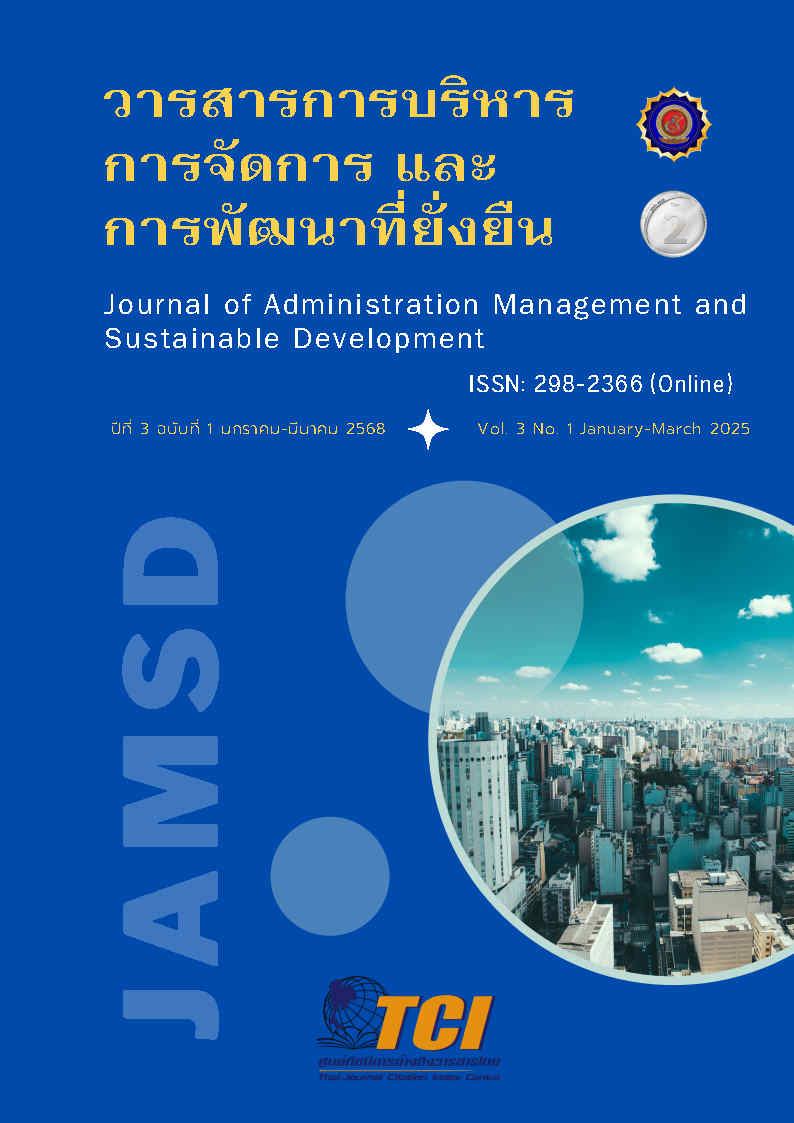Analysis of factors influencing the development of a happy organization for central personnel of the Department of Medical Sciences
Keywords:
Influencing Factor, Happy Organization, Department of Medical SciencesAbstract
This quantitative research aimed to 1. assess the level of happiness within the central personnel of the Department of Medical Sciences, and 2. analyze the factors influencing the creation of a happy workplace for the central personnel of the Department of Medical Sciences. This quantitative study used a sample of 317 personnel, determined by the Krejcie and Morgan sample size table. The research instrument was a questionnaire, and the data were analyzed using percentage, mean, standard deviation, and multiple regression analysis. The results revealed that the overall level of happiness among the central personnel was high, with the highest happiness level reported in peaceful coexistence with society. The study identified six components that influenced the creation of a happy workplace, all rated at a high level. The main factors influencing happiness included organizational culture, welfare and benefits, policies and management, and career advancement. The regression model, with an R2 Square value of 0.698, indicated that these four factors could predict 69.8% of the variance in employee happiness. The linear regression equation is: Y = 1.421 + 0.138(Policies/Management) + 0.099(Career Advancement) + 0.149(Welfare) + 0.226(Organizational Culture). This study provides valuable insights that organizations and management can use as guidelines for promoting the development of a happy workplace.
References
กรมวิทยาศาสตร์การแพทย์. (2566). รายงานการบริหารและพัฒนาทรัพยากรบุคคลตามนโยบายการบริหารทรัพยากรบุคคล ประจำปีงบประมาณ พ.ศ. 2566. สำนักงานเลขานุการกรม กรมวิทยาศาสตร์การแพทย์ กระทรวงสาธารณสุข.
กองทุนสนับสนุนการสร้างเสริมสุขภาพ (สสส.). (2565) แผนหลัก (พ.ศ. 2566 - 2570). กองทุนสนับสนุนการสร้างเสริมสุขภาพ. https://www.thaihealth.or.th/wp-ontent/uploads/2023/01/ สสส-แผนหลัก-66-70-Final.pdf.
จินดา ชัยปัน. (2562). ปัจจัยที่มีผลต่อองค์กรแห่งความสุข (Happy Workplace) กรณีศึกษา คณะเทคโนโลยีอุตสาหกรรม มหาวิทยาลัยราชภัฏอุตรดิตถ์. รายงานวิจัย. อุตรดิตถ์: มหาวิทยาลัยราชภัฏอุตรดิตถ์.
ชาญวิทย์ วสันต์ธนารัตน์. (2551). องค์กรแห่งความสุขด้วยความสุข 8 ประการ. สืบค้น 31 สิงหาคม 2564 จาก https://www.doctor.or.th/article/detail/5572.
ฐณัฏฐ์ อัฑฒ์ทิวัตถ์ธนา. (2567). ทฤษฎี PERMA: กุญแจสู่องค์กรแห่งความสุข. วารสารสังคมศึกษาปริทรรศน์, 1(1), 78-88.
ธนสิทธิ์ สุจริตภักดิ์ และพุทธิไกร ประมวล. (2566). ปัจจัยที่มีผลต่อองค์กรแห่งความสุขของบุคลากรสังกัดสำนักงาน สาธารณสุขอำเภอขุนหาญ จังหวัดศรีสะเกษ. วารสารวิจัยและพัฒนาสุขภาพ ศรีสะเกษ, 2(2), 103-111 .
ธาริน จันทรจตุรงค์, อธิวัฒน์ เจี่ยวิวรรธน์กุล และศิวะพร ภู่พันธ์. (2561). การสังเคราะห์งานวิจัยเกี่ยวกับความสุขในการทำงาน. วารสารดุษฎีบัณฑิตทางสังคมศาสตร์, 8(พิเศษ), 80-91.
ธิดารักษ์ ลือชา. (2561). ตัวแบบการเสริมสร้างความสุขในการทำงานสำหรับบุคลากรในเทศบาลนคร. ดุษฎีนิพนธ์ปรัชญาดุษฎีบัณฑิต สาขาวิชารัฐประศาสนศาสตร์ มหาวิทยาลัยบูรพา.
นูร์ปาซียะห์ กูนา. (2562). ความสุขในการทํางานของบุคลากรองค์การบริหารส่วนตําบลในอําเภอเมืองปัตตานี จังหวัดปัตตานี. สารนิพนธ์ปริญญารัฐประศาสนศาสตรมหาบัณฑิต สาขาวิชารัฐประศาสนศาสตร์ มหาวิทยาลัยสงขลานครินทร์.
บุญชม ศรีสะอาด. (2554). หลักการวิจัยเบื้องต้น พิมพ์ครั้งที่ 9. กรุงเทพฯ: สุวิริยาสาส์น.
พรชนก กุลยะ. (2563). ปัจจัยที่มีผลต่อความสุขและความผูกพันต่อองค์กรของบุคลากร ในสำนักงานสาธารณสุขจังหวัด. วารสารโรงพยาบาลนครพนม, 7(1), 95-104.
พิกุล แสงจันทร์. (2564). ปัจจัยที่มีผลต่อการเป็นองค์การแห่งความสุข กรณีศึกษา: เทศบาลตำบลเชียงรากน้อย อำเภอบางปะอิน จังหวัดพระนครศรีอยุธยา. การค้นคว้าอิสระปริญญาโทรัฐศาสตรมหาบัณฑิต มหาวิทยาลัยรามคำแหง.
ภณิดา บญทวี. (2561). ปัจจัยที่มีผลต่อความสุขในการทำงานของเจ้าหน้าที่ สำนักงานสรรพากรพื้นที่กรุงเทพมหานคร 7 กรมสรรพากร. (สารนิพนธ์ปริญญาการจัดการมหาบัณฑิต มหาวิทยาลัยมหิดล.
ภัทรพล สายแวว. (2564). แนวทางการส่งเสริมองค์กรแห่งความสุขของสถานศึกษาสังกัดสำนักงานเขตพื้นที่การศึกษา มัธยมศึกษาปทุมธานี. วิทยานิพนธ์ปริญญาศึกษาศาสตรมหาบัณฑิต มหาวิทยาลัยเทคโนโลยีราชมงคลธัญบุรี.
ยุพาวรรณ ทองตะนุนาม, ดวงเนตร ธรรมกุล, อัจศรา ประเสริฐสิน, จริยา ชื่นศิริมงคล และศิริพร ครุฑกาศ. (2558). ปัจจัยพัฒนาองค์กรแห่งความสุข (ภาครัฐ): การทบทวนวรรณกรรมอย่างเป็นระบบ. กองทุนสนับสนุนการสร้างเสริมสุขภาพ (สสส.). (2565) แผนหลัก (พ.ศ. 2566-2570). กองทุนสนับสนุนการสร้างเสริมสุขภาพ. https://www.thaihealth.or.th/wp-ontent/uploads/2023/01/ สสส-แผนหลัก-66-70-Final.pdf. 9 (1), 52-62.
วรญา สาราณิยกิจ. (2565). การศึกษาปัจจัยด้านสุขภาวะที่ดีและความสุขขององค์กรที่ส่งผลกระทบต่อความยั่งยืนในบุคลากรภาครัฐในเขตกรุงเทพมหานคร. สารนิพนธ์การจัดการมหาบัณฑิต มหาวิทยาลัยมหิดล.
วรรณภา ลือกิตินันท์ และกมลมาลย์ พลโยธา. (2559). โครงการรวบรวมวรรณกรรมเกี่ยวกับความสุขในการทำงานและองค์กรสุขภาวะ. รายงานการวิจัย. สำนักงานกองทุนสนับสนุนการสร้างเสริมสุขภาพ.
วัลลภา องคไทร. (2561). ปัจจัยที่ส่งผลต่อการสร้างองค์กรแห่งความสุขในโรงเรียนประถมศึกษา อำเภอนครชัยศรี สังกัดสํานักงานเขตพื้นที่การศึกษาประถมศึกษา นครปฐมเขต 2. การศึกษาค้นคว้าอิสระศึกษาศาสตรมหาบัณฑิต สาขาวิชาศึกษาศาสตร์ มหาวิทยาลัยสุโขทัยธรรมาธิราช.
สุวิมล ติรกานันท์. (2555). การวิเคราะห์ตัวแปรพหุในงานวิจัยทางสังคมศาสตร์. กรุงเทพฯ: โรงพิมพ์แห่งจุฬาลงกรณ์ มหาวิทยาลัย.
อภิสรา เปาอินทร์. (2562). ปัจจัยที่มีผลต่อความสุขในการทำงานของพนักงานธนาคารแห่งประเทศไทย. การค้นคว้าอิสระรัฐศาสตรมหาบัณฑิต สาขาวิชาบริหารรัฐกิจและกิจการสารธารณะ มหาวิทยาลัยธรรมศาสตร์.
เอื้องคำ จันทะพรม. (2564). ปัจจัยที่ส่งผลต่อความสุขในการทำงานของพนักงานองค์การบริหารส่วนจังหวัดสกลนคร. วิทยานิพนธ์รัฐประศาสนศาสตรมหาบัณฑิต มหาวิทยาลัยราชภัฏสกลนคร.
adnan Bataineh, K. (2019). Impact of Work-Life Balance, Happiness at Work, on Employee Performance. International Business Research, 12(2), 9-112.
Anjum, N. & Islam, A. (2021). Workplace Happiness: Exploring the Factors Shaping Academics' Subjective Well-being. Journal of Management in Practice. 6(1), 1-23.
Awada, N. I. & Ismail, F. (2019). Happiness in the Workplace. International Journal of Innovative Technology and Exploring Engineering, 8(9), 2278-3075.
Cronbach, L. J. (1990). Essentials of psychological testing (5th ed.). New York: Harper & Row.
Durbin, J. & Watson, G. S. (1951). Testing for serial correlation in least squares regression, II. Biometrika, 38(1-2), 159–179.
Krejcie, R.V. and Caryle Morgan. (1977). Educational Psychology, 3rd ed. New York: Harcourt Brace.
Jianchun, Y. (2024). Enhancing employee job satisfaction through organizational climate and employee happiness at work: A mediated–moderated model. BMC Psychology, 1(2), 744-769. https://doi.org/10.1186/s40359-024-02269-5.
Joo, BK. & Lee, I. (2017). Workplace happiness: work engagement, career satisfaction, and subjective well-being. Evidence-based HRM: a Global Forum for Empirical Scholarship, 5(2), 206-221.
Judge, T. A. & Zapata, C. P. (2015). The person-situation debate revisited: Effect of situation strength and trait activation on the validity of the Big Five Personality Traits in predicting job performance. Academy of Management Journal, 58(4), 1149–1179.
Sarwar, N., Bung, P., Shaikh, M., Jaiswal, R., Malla, M., & Rajni. (2023). A Study on Factors Influencing Workplace Happiness and Its Relationship with Job Satisfaction, Employee Retention and Work Performance. Journal of Informatics Education and Research, 3(2), 1526-1540.
Seligman, M. E. P. (2002). Positive Psychology, Positive Prevention and Positive Therapy. In C. R. Snyder, & S. J. Lopez (Eds.), Handbook of Positive Psychology. New York, NY: Oxford University Press.






